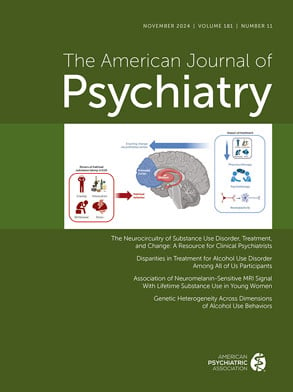The research agenda for DSM-V emphasizes a need to translate basic and clinical neuroscience research findings into a new classification system for all psychiatric disorders based upon pathophysiologic and etiological processes
(1 –
4) . It is becoming increasingly clear, however, that we need to move toward identifying endophenotypes that not only reflect underlying pathophysiologic processes specific to a disorder but that also mediate response to specific treatments to help guide our treatment choice for individuals as early as possible in their illness course.
In this issue of the Journal, three articles highlight the need in psychiatry for improved means of identifying as early as possible subgroups of individuals with a given psychiatric disorder who will respond preferentially to a specific treatment. Two of these articles demonstrate that neuroimaging techniques may provide a methodology to help us achieve this ultimate goal.
In one article, Frank et al. present data identifying a subgroup of individuals from a larger group of 233 female adults with unipolar depression who were able to achieve remission with interpersonal therapy alone and for whom maintenance interpersonal therapy, even at a frequency of only one visit per month, was a good method of prophylaxis. In contrast, they show that for women who required the addition of pharmacotherapy to achieve remission, interpersonal therapy monotherapy was a significantly less efficacious maintenance treatment. A key concluding point the authors make is that while they were able retrospectively to identify the subgroup of women who responded well to both acute and maintenance interpersonal therapy, none of the traditional measures of depression severity or other parameters of illness distinguished that subgroup from those who required the combination therapy to achieve and maintain remission. They argue for “new ways of distinguishing the various phenotypes of unipolar disorder for which treatment requirements differ.”
In a second article in this issue of the
Journal, Kennedy et al. present the first study to examine in unipolar depression patients abnormalities in neural systems that mediate response to two contrasting interventions for unipolar depression: venlafaxine and cognitive behavior therapy (CBT). Both venlafaxine (N=12) and CBT (N=12) were administered as monotherapy to a group of adults with unipolar depression in the context of an extended 16-week randomized comparative trial. Using fluorine-18-fluorodeoxyglucose positron emission tomography to measure cerebral glucose metabolism, the authors show in treatment responders three broad patterns of changes in cerebral metabolism in corticolimbic regions associated with mood and emotion regulation
(5) . These include 1) changes common to both CBT and venlafaxine responders, 2) opposite patterns of change in responders to each intervention, and 3) changes unique to each intervention. They were also able to determine changes that identified nonresponders to each treatment. This study builds on existing data indicating “differential changes in regional brain activity following response (and nonresponse) to pharmacotherapy compared with psychotherapy”
(6 –
12) but is the first to make a direct comparison between changes in neural activity associated with these two treatment modalities in the context of a randomized controlled trial.
There are limitations to this study, including the relatively small cohort size, the generalizability of findings to real-world populations of depressed patients, and the acquisition of resting-state rather than emotion or cognitive challenge neuroimaging scans. As the authors point out, their findings lead directly to consideration of a crucially important area of psychiatric neuroimaging research, namely, the feasibility of identifying neuroimaging predictors of treatment response in unipolar depression. They argue that examination of baseline, pretreatment patterns of cerebral metabolism may help identify those individuals who subsequently respond best to each intervention. This emerging area of neuroimaging research has the potential to fulfill the ultimate goal of identifying treatment-relevant endophenotypes, not only in unipolar depression but in all major psychiatric disorders.
In a timely brief report, Ma et al. present data that indicate pretreatment abnormalities in neural circuitry underlying mood regulation in 14 young adults with unipolar depression. In the first diffusion tensor imaging study of treatment-naive young adults with unipolar depression, the authors show that abnormalities of white matter are present early in the course of illness in four regions, including a prefrontal cortical region linked with mood regulation and cognitive control similar in nature to one of the regions identified by Kennedy et al. While this is a relatively small study, the findings indicate the feasibility of employing diffusion tensor imaging and, indeed, other neuroimaging modalities, not only to identify abnormalities that exist before treatment in neural systems in individuals with psychiatric disorders but also those abnormalities that may predict subsequent clinical course and treatment response.
Can neuroimaging really help us achieve the goal of identifying treatment-relevant endophenotypes in unipolar depression or, indeed, other psychiatric disorders? First, we have evidence demonstrating the feasibility of neuroimaging techniques in helping to identify neural system abnormalities that mediate clinical change in unipolar depression. We then have further evidence that neuroimaging techniques can identify pretreatment abnormalities in neural systems important for mood regulation that closely overlap in nature with neural system abnormalities shown to mediate treatment response in unipolar depression.
Do different types of pretreatment neural system abnormalities in individuals with psychiatric illness characterize subsequent treatment response? Emerging data from preliminary neuroimaging studies suggest so
(13,
14) . We are surely now in a position in psychiatry to fully embrace the potential of neuroimaging and other basic and clinical neuroscience findings to help us identify neural system abnormalities that are more accurate than traditional clinical measures in characterizing subgroups of individuals who will subsequently respond best to different treatment modalities.

